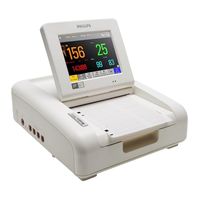Philips Avalon FM20 Manuals
Manuals and User Guides for Philips Avalon FM20. We have 2 Philips Avalon FM20 manuals available for free PDF download: Service Manual, Instructions For Use Manual
Philips Avalon FM20 Service Manual (261 pages)
Table of Contents
-
Alarms12
-
Introduction15
-
Power Supply40
-
I/O Boards41
-
Interfaces47
-
Broadcast52
-
Unicast52
-
Introduction55
-
Safety Tests59
-
System Test71
-
Leakage Test84
-
Valve Test84
-
Troubleshooting105
-
Trace Header106
-
Screen Is Blank111
-
Alarm Tones115
-
Fetal Recorder115
-
USB Troubles119
-
Status Log123
-
Parts List125
-
Monitor125
-
Transducers126
-
Patient Modules127
-
Interface Cables127
-
Contents130
-
Drawer Assembly133
-
Display Assembly133
-
Battery Assembly134
-
Belt Button Kit135
-
Tools Required140
-
Serial Numbers141
-
Connectors195
-
Upgrade Options213
-
Connectors226
-
Recorder Symbols238
-
EMC Testing243
-
Environment250
-
Index255
-
Monitor256
-
Belt Button256
-
Changing256
-
Kit Contents256
-
Interface256
-
Main CPU256
-
Failures256
-
Transducers257
-
Recorder Adapter257
-
Nibp 42 , 83257
-
Example257
-
Password257
-
Disassembly257
-
Ecg257
-
Transducer257
-
Calibration257
-
Alarm258
-
Display258
-
Touchscreen258
-
Transducers258
-
Transducer258
Advertisement
Philips Avalon FM20 Instructions For Use Manual (221 pages)
Fetal Monitor
Table of Contents
-
-
Settings33
-
-
5 Alarms
63
-
-
Troubleshooting102
-
-
What You Need129
-
Toco Sensitivity130
-
Troubleshooting131
-
-
-
What You Need133
-
Troubleshooting135
-
-
-
What You Need137
-
Monitoring DECG139
-
Troubleshooting141
-
-
Calibration148
-
Troubleshooting148
-
-
-
Troubleshooting160
-
Advertisement

